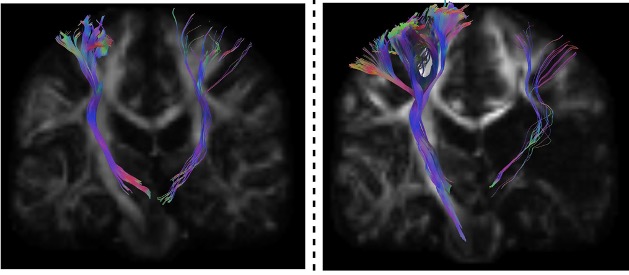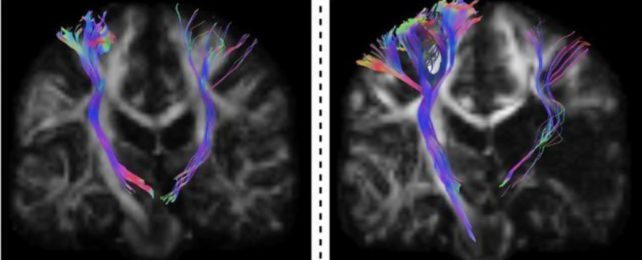Two stroke patients have been able to move their hands again after an experimental procedure that feels 'like a tickle' temporarily restored weakened connections between their upper limbs, brain, and spinal cord.
Heather Rendulic is one of those two women. For one month, as part of a pioneering study led by researchers at the University of Pittsburgh, she was able to maneuver her disabled arm more easily when electrical pulses were zapping at her upper spinal cord.
Rendulic had a stroke in her early 20s that paralyzed the left side of her body. Like many stroke survivors, she regained some stilted movement but her recovery soon plateaued and many daily tasks like tying shoelaces or chopping vegetables were out of her grasp.
For years Rendulic has been "living one-handed in a two-handed world" – but has now glimpsed what might be possible for some stroke patients, years from now, if spinal cord stimulation proves safe and effective.
"When the stimulation is on, I feel like I now have control of my arm and my hand again, that I haven't had in over nine years," says Rendulic.
"The stimulation feels kind of like a tickle, and it's never painful, but it takes some getting used to, I'd say."
While only two cases are reported in the study, Rendulic and the other participant both showed clear improvements in grip strength, arm movement, and hand dexterity almost immediately after the device was switched on.
The device consisted of a pair of thin metal electrical implants – flexible like strands of spaghetti – inserted into the top part of the spinal cord where it joins with sensory inputs from the arm and hand.
When switched on, the electrodes delivered pulses of electricity to spinal circuits that had been weakened by stroke but remained intact. Rather than forcing the muscles to move, the pulsed current amplifies messages in the spine's neural circuits to assist movement.
"We wanted to pick up on these weak signals and essentially turn them into functional outputs so that a person would be able to control their own hand voluntarily," University of Pittsburgh biomedical engineer and senior author Marco Capogrosso told NPR.

The two women in this study suffered from different kinds of strokes, but both showed improved hand and arm movements to varying degrees. They received the experimental form of stimulation for four hours a day, five days a week, over a month-long trial period.
In a series of tests captured on video and with wireless sensors detecting muscle contraction, Rendulic can be seen liftering her arm, grabbing a soup can, nabbing morsels of food with a fork, opening a lock, and drawing basic shapes.
These dexterous movements, combined with the wide range of motion of the arm and shoulder, have posed a greater challenge than stimulating leg movement, the researchers say – though both are remarkable feats.
Just last year, researchers reported that nine people were able to walk again with assistance after five months of spinal cord stimulation and rehabilitation.
Prior to this, a 2016 study had shown electrical stimulation might also improve upper limb movement after spinal cord injury. And with further testing in animals and computer modeling, the researchers behind this latest study were encouraged to believe stroke survivors may benefit too.
To the researchers' surprise, some of the improvements to mobility lasted up to four weeks after the implants were removed – but those gains have since dissipated, Rendulic says.
"We found that after a few weeks of use, some of these improvements endure when the stimulation is switched off, indicating exciting avenues for the future of stroke therapies," says Capogrosso. This hints at the possibility that spinal cord stimulation may not only assist arm function, but potentially restore a portion of it if the therapy is used over longer periods.
Researchers not involved in the study are excited too that the promising results first seen with spinal cord injuries look like they can be replicated for stroke.
"However, small patient numbers and results must be validated in a larger study," tweeted Euan McCaughey, a biomedical engineer studying electrical stimulation for spinal cord injuries.
Those studies may take years to come to fruition, but the results will be key to understanding which types of stroke patients may benefit from the therapy, at what stage of recovery, and if there are any safety issues or limits to its efficacy.
"This is for research purposes, it's very early," Eellan Sivanesan, director of neuromodulation at Johns Hopkins University, told STAT News.
"There's promise. It's good to have hope, but I don't want to mislead patients that this is something that's going to be available for them tomorrow."
Hope is indeed what the researchers have, that when coupled with ongoing physical therapy, the approach may provide some lasting benefit to stroke patients. But the cost of surgery to implant electrodes may be still a barrier to many.
Rendulic also hopes that her participation in the study has helped researchers, and that someday in the future she can get a permanent stimulator to tickle her nerves once more.
The research has been published in Nature Medicine.
